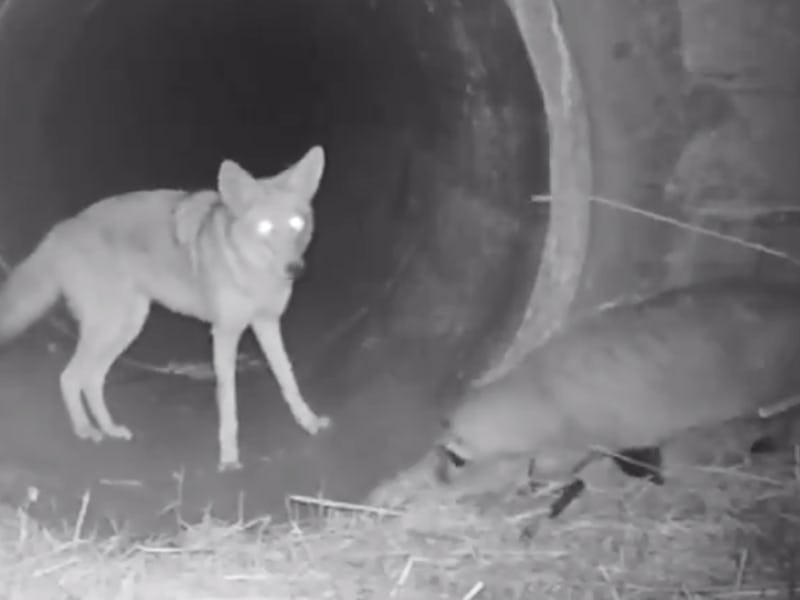Coyote-badger duo: 28-year-old study explains the science behind viral video
The research behind these animal BFFs.

Look at them go.
On Monday, an adorable video of a coyote-badger duo posted to Twitter took the internet by storm.
In the video, a coyote and a badger can be seen traveling together through a giant drain pipe to avoid crossing a busy highway in California.
But what brings these two together in nature is even more intriguing than the video itself. And it is all explained by a scientific study that came out nearly 30 years ago.
In a 1992 study, researchers reported that coyotes and badgers are great partners when it comes to hunting. When coyotes hunt alongside their badger companions, they are more adept at snagging their prey — in this case, Uinta ground squirrels. They were also able to cover more ground with badgers than alone, increasing their available hunting grounds.
Badgers, in turn, spent more time below ground and active when they were with coyotes — which suggests they didn’t have to work as hard to find their food when they had a partner. Together, the researchers found, the animals make a killer combo.
“Overall, prey vulnerability appeared to increase when both carnivores hunted in partnership,” the researchers wrote.
The intriguing results appeared in the Journal of Mammalogy.
Why do coyotes and badgers help each other?
It may seem counterproductive for two species competing for the same prey to work together. So why does it work?
These “temporary hunting associations” are the result of the complementary traits coyotes and badgers share — like body shape and hunting strategy. Here's why these traits make them a great team:
Badgers are adept at digging for their prey, which tend to be small animals that hide in long, deep, underground tunnels. Badgers trap prey animals like ground squirrels by plugging up their burrows. Coyotes, however, are skilled in the chase-and-pounce strategy of hunting — but it only works if the prey is already above ground. Hunting in the brush can (literally) trip up a coyote’s success — that is where the badgers come in.
Coyote on the hunt in the autumn light.
For the 1992 study, researchers observed coyotes waiting near a hunting badger, anticipating the moment when the badger’s digging flushed squirrels from their burrows. In turn, a squirrel that detects a nearby coyote keeping watch might hunker down in its burrow, allowing the badger more time to dig away and capture it.
In areas where squirrels are more densely populated far more coyotes partnered with a badger than hunted alone, the researchers found.
The clever coyotes “saved energy and (possibly) time via decreased searching, stalking, and chasing,” the paper’s authors found. “They mostly waited for the opportunity to quickly scramble and capture a squirrel.”
Certain conditions increase the likelihood of these kinds of mutual efforts, the researchers found. The study, conducted at the National Elk Refuge in Wyoming, illustrates some of the factors that help strengthen the partnership:
- Relatively high densities of both predators and prey
- Relatively long-living predators
- Forest structure that hinders solo hunting by coyotes
- Well-connected prey burrows that impede badgers’ hunting success
- Little interaction with humans
- A “stressful physical environment”
History of hunting partnerships
Clearly, this dynamic duo didn’t start with a viral video in 2020, or even a piece of research from 1992. The partnership is described in Native American folklore, which includes tales of badgers and coyotes hunting together. Early European colonizers who came to North America noted similar associations — as have naturalists and scientists.
American Badger hunting prairie dogs at Theodore Roosevelt National Park
Coyotes and badgers aren't the only animals that team up to hunt. Ravens and wolves may work as hunting partners, too, reports The Cornell Lab. Ravens' ability to fly overhead allows them to scout out prey, while wolves’ expert hunting often leaves behind tasty scraps for ravens to scoop up. The presence of ravens may also encourage wolves to hunt in packs, the research suggests.
Grey wolves and striped hyenas have also been observed hunting in tandem. The two creatures work together as scavengers in the Negev Desert in southern Israel, as The Washington Post reported in 2016. Together, they track down animals, insect, plants, trash — sometimes even hunting within the same pack. In the sparse desert environment, that friendship may be critical to both animals' survival.
So while these moments make for adorable video opportunities, animal duos that deliberately pay it forward reveal just how smart our fellow animals are.
Abstract: Coyotes (Canis latrans) associating with badgers (Taxidea taxus) appeared to hunt Uinta ground squirrels (Spermophilus armatus) more effectively than lone coyotes. Coyotes with badgers consumed prey at higher rates (P ~ 0.09) and had an expanded habitat base and lower locomotion costs. Badgers with coyotes spent more time below ground and active (P = 0.02), and probably had decreased locomotion and excavation costs. Overall, prey vulnerability appeared to increase when both carnivores hunted in partnership. Complementary morphological adaptations and predatory strategies, interspecific tolerance, and behavioral flexibility allowed them to form temporary hunting associations. The following ecological circumstances may have increased the likelihood of this interaction in our study area: relatively high densities of predators and prey; relatively long~lived predator populations; a vegetative structure that impeded solitary hunting by coyotes; a high connectivity of prey burrows that decreased hunting success of badgers; an absence of interaction with humans; a stressful physical environment.